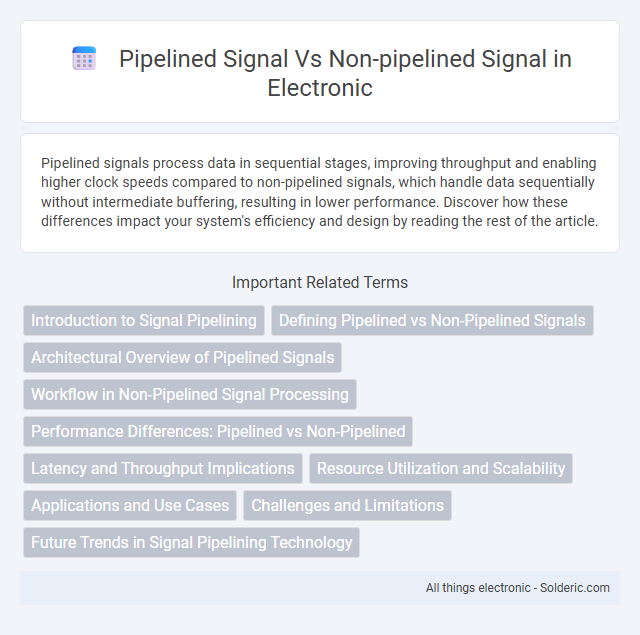Pipelined signals process data in sequential stages, improving throughput and enabling higher clock speeds compared to non-pipelined signals, which handle data sequentially without intermediate buffering, resulting in lower performance. Discover how these differences impact your system's efficiency and design by reading the rest of the article.
Comparison Table
| Feature | Pipelined Signal | Non-Pipelined Signal |
|---|---|---|
| Definition | Signal processed through multiple pipeline stages for faster computation. | Signal processed in a single stage without intermediate storage. |
| Latency | Higher overall latency due to stage delays. | Lower latency as processed in a single pass. |
| Throughput | High throughput due to parallel stage operation. | Lower throughput limited by sequential processing. |
| Complexity | Higher design complexity with registers and control logic. | Simpler design with minimal control and no stage registers. |
| Clock Frequency | Supports higher clock frequencies using stage pipelining. | Operates at lower clock frequencies limited by combinational delay. |
| Resource Usage | Increased hardware resources due to stage registers. | Less hardware required with no additional registers. |
| Use Cases | High-speed DSP, CPUs, and systems requiring high throughput. | Simple control logic, low-speed or latency-sensitive applications. |
Introduction to Signal Pipelining
Signal pipelining enhances data processing speed by breaking tasks into smaller stages that execute simultaneously, unlike non-pipelined signals which process tasks sequentially. This technique reduces latency and increases throughput, making it essential in modern digital circuits and communication systems. Understanding pipelined signals enables you to optimize system performance by efficiently managing timing and resource allocation.
Defining Pipelined vs Non-Pipelined Signals
Pipelined signals refer to data signals processed through sequential stages in hardware design, allowing simultaneous processing of multiple data elements, which increases throughput and reduces latency. Non-pipelined signals, by contrast, complete their processing in a single stage, causing each operation to wait for the previous one to finish, thus limiting speed and efficiency. Understanding the difference between pipelined and non-pipelined signals helps you optimize system performance by leveraging concurrent data flow and reducing bottlenecks.
Architectural Overview of Pipelined Signals
Pipelined signals utilize a series of registers or stages that process data in overlapping intervals, enabling higher throughput and improved clock speeds compared to non-pipelined signals, which handle data sequentially without intermediate storage. The architectural design of pipelined signals partitions operations into multiple pipeline stages, each responsible for a specific task, effectively reducing latency per operation while increasing overall system performance. This staged processing approach contrasts with non-pipelined architectures that rely on a single execution unit, resulting in slower data propagation and limited performance scaling.
Workflow in Non-Pipelined Signal Processing
Non-pipelined signal processing follows a sequential workflow where each task must complete before the next begins, leading to potentially longer processing times and limited throughput. This linear approach processes signals step-by-step, making it simpler but less efficient for high-speed or real-time applications. Understanding this workflow helps you identify scenarios where non-pipelined processing may be suitable due to its straightforward implementation and lower resource requirement.
Performance Differences: Pipelined vs Non-Pipelined
Pipelined signals improve performance by allowing multiple instructions to overlap during execution, significantly increasing throughput and reducing latency compared to non-pipelined signals, where each instruction must complete before the next begins. Non-pipelined designs often suffer from longer execution times and lower efficiency due to the sequential processing of signals. Your system's speed and responsiveness benefit greatly from employing pipelined signals, especially in complex or high-speed data processing tasks.
Latency and Throughput Implications
Pipelined signals significantly reduce latency by allowing multiple processing stages to operate concurrently, resulting in faster data propagation compared to non-pipelined signals where each stage waits for the previous one to complete. Throughput is increased in pipelined designs because new inputs can enter the pipeline every clock cycle, enabling continuous data processing, whereas non-pipelined signals process data sequentially, limiting throughput to one operation at a time. Your choice between pipelined and non-pipelined signals directly impacts system performance, with pipelining offering higher throughput and lower latency for high-speed applications.
Resource Utilization and Scalability
Pipelined signals enhance resource utilization by allowing overlapping execution of multiple instructions, which maximizes hardware efficiency and throughput. Non-pipelined signals utilize resources sequentially, leading to idle periods and underutilization of hardware components. Scalability is improved in pipelined designs as incremental stages can be added to accommodate higher performance demands without redesigning the entire system, unlike non-pipelined approaches where scaling requires proportionally more hardware.
Applications and Use Cases
Pipelined signals are essential in high-speed digital systems such as microprocessors and network routers, where they enable parallel processing and increase throughput by breaking tasks into stages. Non-pipelined signals are preferred in simpler or real-time control applications like embedded systems or analog signal processing, where latency and deterministic timing are critical. Your choice depends on balancing performance needs with system complexity and timing requirements.
Challenges and Limitations
Pipelined signals face challenges such as increased complexity in timing control and the need for additional hardware resources to manage intermediate data states, which can lead to higher power consumption. Non-pipelined signals are limited by slower data throughput and increased latency due to sequential processing without overlapping operations. Signal integrity issues like glitches and synchronization errors become more pronounced in pipelined systems, complicating design and verification processes.
Future Trends in Signal Pipelining Technology
Future trends in signal pipelining technology emphasize increasing data throughput and reducing latency by integrating advanced machine learning algorithms and adaptive control mechanisms. Innovations in hardware, such as photonic and quantum computing components, promise to transform traditional pipelined signal processing by enabling ultra-fast and energy-efficient operations. Your designs will benefit from these developments through enhanced signal integrity and real-time processing capabilities in complex communication and computing systems.
pipelined signal vs non-pipelined signal Infographic

 solderic.com
solderic.com